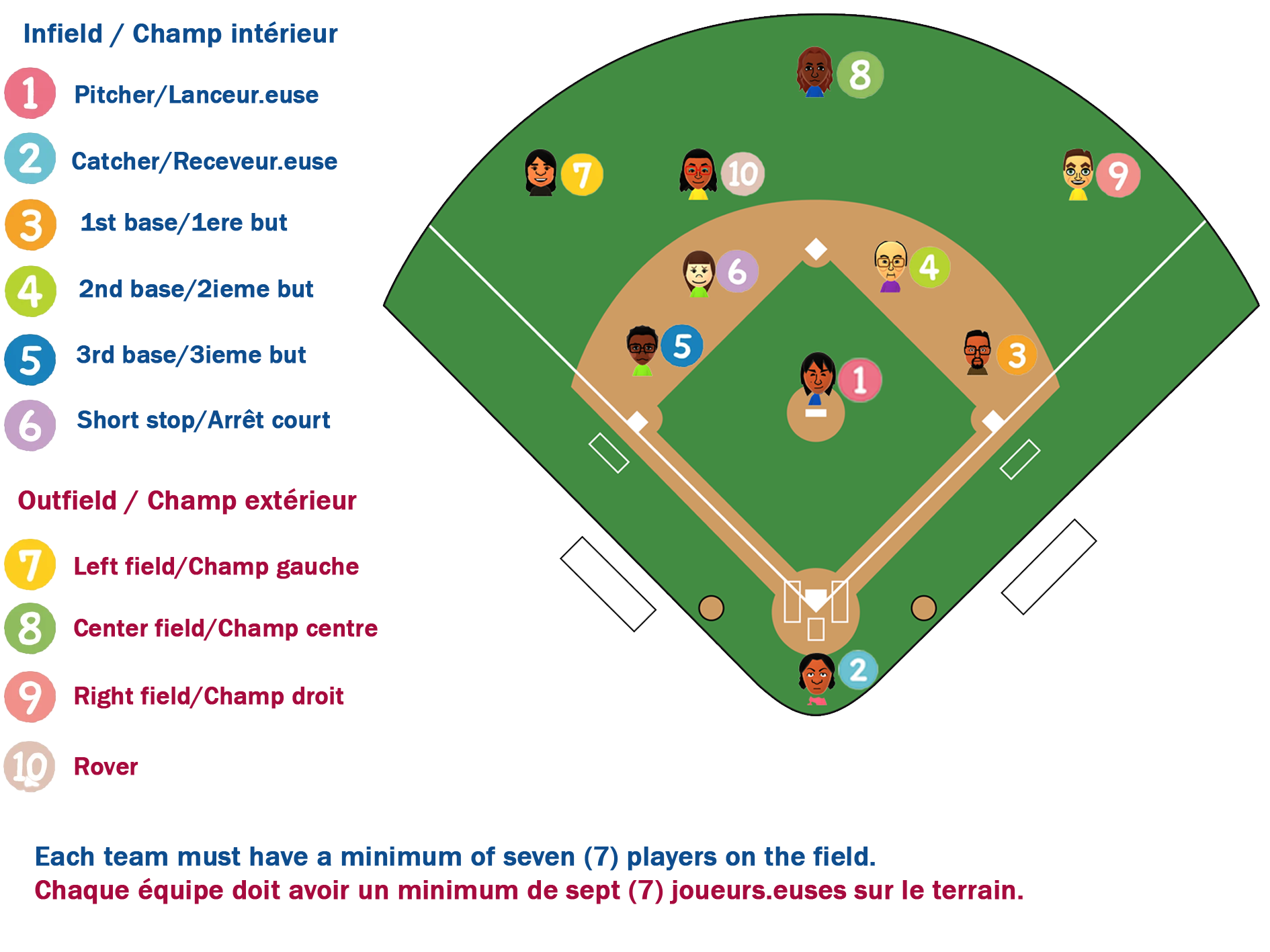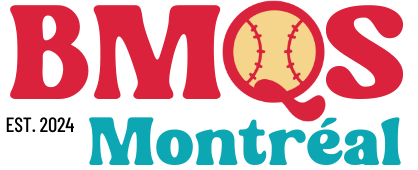League Rules:
We generally follow Softball Canada rules, except where they conflict with our league rules, given below. Rules related to uniforms or dress codes that are not related to safety do not apply. Rules concerning the sex or gender of players are also not applicable.
- Teams must arrive at least 15 minutes prior to the opening pitch.
- Each team is responsible for their own stats and scorekeeping.
- There must always be at least 7 players from each team on the field.

- Each team is responsible for bringing their own equipment, including gloves, bats (all bats are allowed except senior leagues bats — 1.20 BPF and under is allowed), and extra softballs (105 style balls).
- Each team is responsible for bringing a first aid kit to games.
- A pitcher’s and catcher’s mask are required at all times.
- Batting helmets are permitted but not required.
- Metal cleats are prohibited.
- Use of a pitching net is encouraged but not required.
- Teams must wear matching jerseys or shirts in colours that are clearly distinguishable from the opposing team.
- General Rules and Regulations:
- Game duration is 1 hour and 25 minutes hours or 7 innings, whichever occurs first.
- Each team must have a minimum of 7 players by the opening pitch, otherwise, the game will be forfeited and recorded as a 7-0 loss.
- New innings cannot commence within 10 minutes of the scheduled end time, to accommodate teams waiting to play.
- In the event of hazardous playing conditions, games may be canceled completely or cut short, with the final score determined by the last completed inning.
- Alcohol is prohibited on the field.
- Scoring:
- During any inning, a team may score up to 6 runs, except for the final inning, where there is no run limit.
- During the playoffs, if a game is tied after 7 innings or 1.5 hours have elapsed, teams will use the following tie-breaker format: The visiting team starts with the last person out from the last inning on second base. Batting will resume with the next batter. There will be considered 2 outs – play proceeds until 3 outs, then the home team does the same, repeating until the tie breaks.
- Pitching:
- The pitcher must be a player from the team at bat (self-pitch).
- The pitcher is prohibited from interfering with the ball, and once a play is active, they must promptly move out of the way to facilitate defensive play as much as possible.
- Wild pitches and balls are considered pitches.
- A ball hit with a full swing, which doesn’t pass the pitcher, remains in play so long as it passes the bunt line.
- Batting:
- A team must use their full roster for batting (i.e. players cannot only play defense).
- Each batter has three swings to a maximum of five pitches.
- On-deck batters must not be on the field of play before their turn to bat.
- If a hit ball strikes the pitcher, it is not a pitch or a swing, it is a dead ball, and the pitch is re-taken.
- Bunting is prohibited. A hit ball that does not pass the bunt line is considered a foul ball and will count as a swing.
- If a batted ball hits the pitching net, it is considered a dead ball and no play may be made. It will not count as a swing or a pitch.
- Sliding:
- Sliding is permitted when reaching second and third bases. Sliding into first base is allowed only if a player is returning from second base.
- Base Running, Tagging, and Fielding:
- Leading is prohibited. The runner is deemed out if they leave the base before the bat connects with the ball.
- Any ball hit foul but is still in the field of play can be caught for an out.
- When a ball is fouled back to the catcher, it must rise above the catcher’s shoulders after hitting the bat to be able to be caught for an out.
- Runners not compelled to advance must be tagged with the ball to be considered out.
- When running from home to first base, the runner is safe if they touch and move past the base, as long as they do not turn to run to second base.
- When running from third base to home plate, the runner must stay outside the baseline.
- When running from third base to home base, once the runner passes the commitment line, they cannot return to third base (force play to home), except in the case that they need to tag up according to the tagging up rule, or in the case that they missed a base and run in reverse to touch the base.
- If a runner touches home plate while attempting to score, it’s an automatic out. Runners must cross the home base line outside the baselines, without touching home plate.
- The runner is out if the catcher, holding the ball, touches home plate before the runner crosses the line.
- Tagging up rule: If a fly ball is caught, all runners must return to their previous bases. A runner who returns to their base after the catch may then attempt to advance to the next base. If a player touches the previous base with the ball before a runner returns to their previous base, they are out.
- Infield pop fly rule: If there are fewer than 2 outs and there are runners on base, and a pop fly is hit into the infield, the ball is considered caught if it could reasonably have been caught—whether or not a player actually catches, misses, or drops it. The batter is out, and the runners must remain on their bases. This rule is in place to prevent the defensive team from intentionally dropping the ball to attempt a double play.
- 1.1 A thrown ball which goes out of play in any manner will be declared an overthrow. Any runner or runners will be awarded one base in addition to the base to which the runner was advancing when the overthrow was made.
- I.2. A thrown ball which goes into the dugout area or over the backstop will be declared an overthrow with all runners advancing according to rule I.2.
- 1.3 In the above rules 1.1 and I.2, the ball will be declared a dead ball once the overthrow has occurred.
- A ball is deemed out of play if it leaves the ball field. Anything outside normal play field and foul lines. For example the dugouts or stands.
- If a ball is hit and flies over the warning track (the sand going around the outside of the field and past the yellow foul post) on Laurier 1, or flies over the back fence on Laurier 2, this will be deemed a home run.
- If the ball lands in the outfield within play and rolls out of play (past the warning track/yellow foul posts on Laurier 1, under the back fence on Laurier 2), it is a ground rule double. All base runners and the batter only advance 2 bases and the play is deemed over.
- A force play occurs when a runner is forced to advance to the next base because there is a runner on the base behind them. For a forced out to occur, the defense must touch the base before the runner while in possession of the ball. When there is not a force play, runners who are not required to advance must be tagged with the ball to be out.
- Ex 1: Runners are on first and second, and a ball is hit into play — the runners must advance to their next base because they are forced by the other runner/batter.
- Ex 2: Runner is on second, first base is unoccupied, and a ball is hit into play — the runner on second does not have to advance to third, as there is no runner on first base.
- Pinch Runners:
- A pinch runner may run in the place of any batter who cannot or does not want to run the bases.
- The pinch runner must be someone from the batter’s team.
- The pinch runner starts from behind the plate, and once contact is made, they may start running.
- Disputes:
- The priority of this league is to have fun and build community. It’s fine to express that you think a call is wrong, at the same time it’s important not to escalate, and to remember that this is all for fun, which means that sometimes it’s better to just let things go.
- If a game is umpired, it is prohibited to dispute an umpire’s call based on judgement alone. Questions based on interpretation of a rule or rules may be raised politely by the team captain(s) only. Arguing with umpires about a call can lead to expulsion from the game.
- Captains should note that some calls can only be made by the umpire upon appeal from the opposing team.
- Unless appealed to, the umpire does not call a player out or penalize them for having failed to touch base, leaving a base too soon on a caught fly ball, batting out of order, being an unreported substitute, being an Illegal Re-Entry, being a runner who switched positions on bases with another runner, or making an attempt to go to second base after reaching first base.
